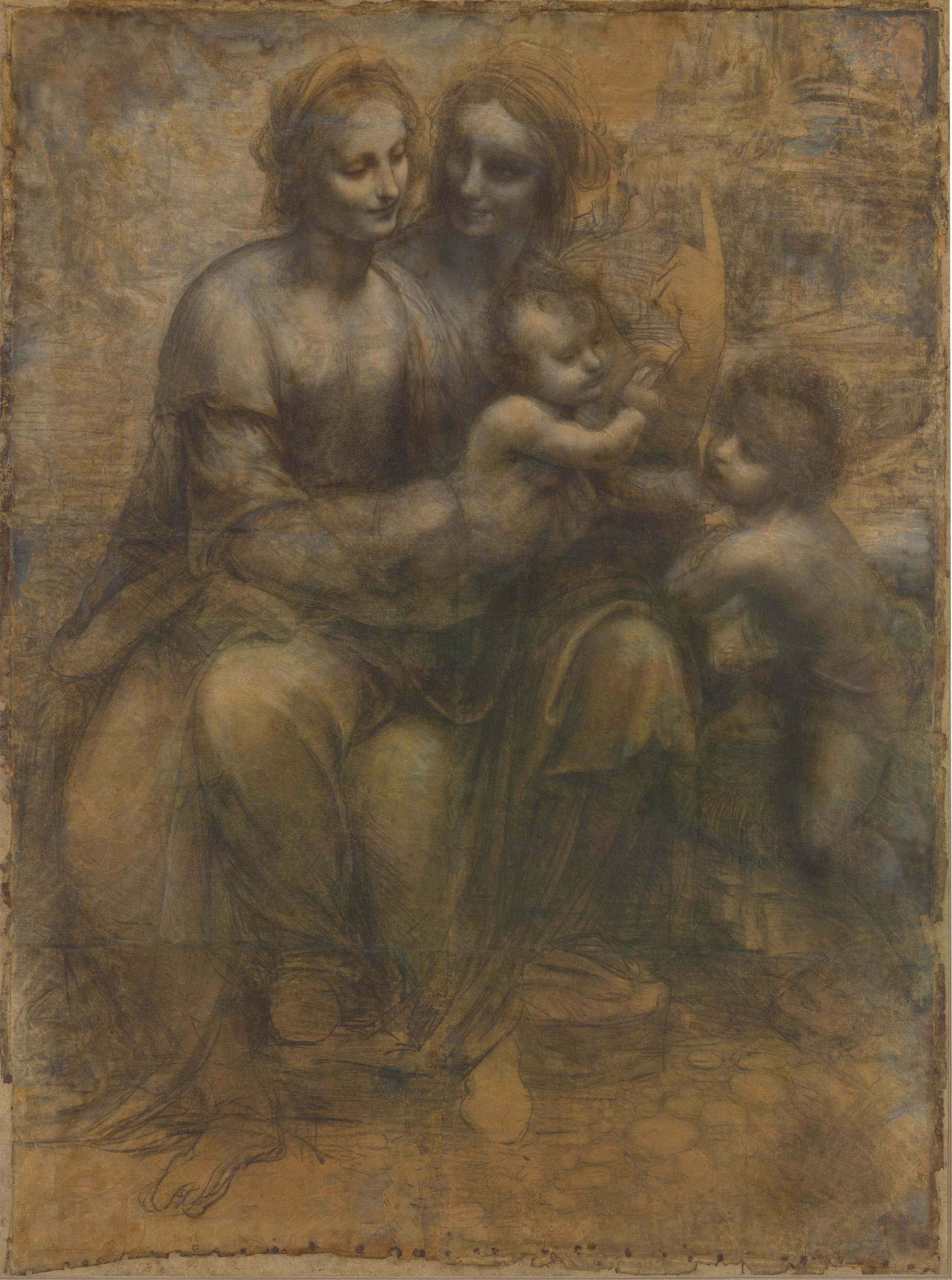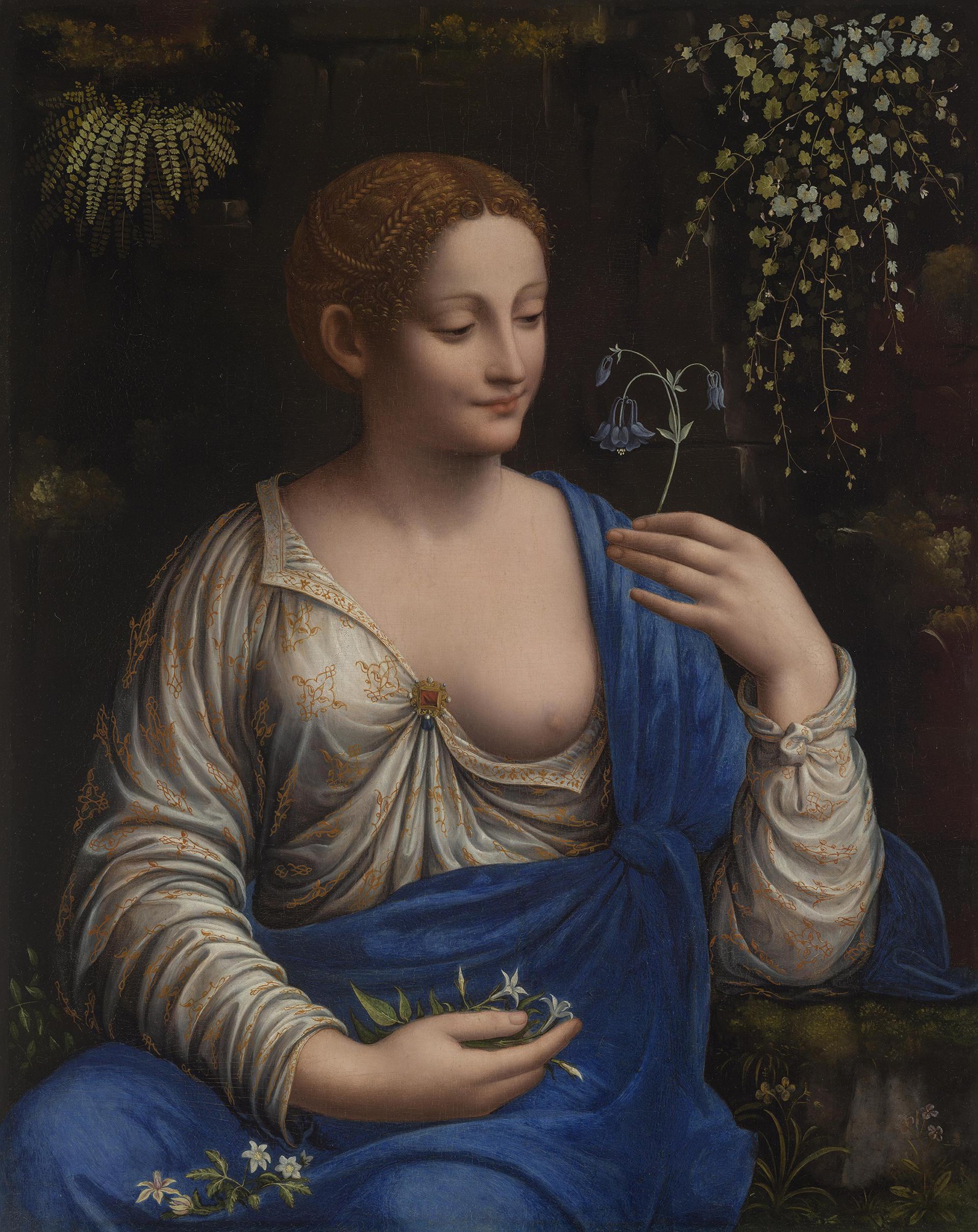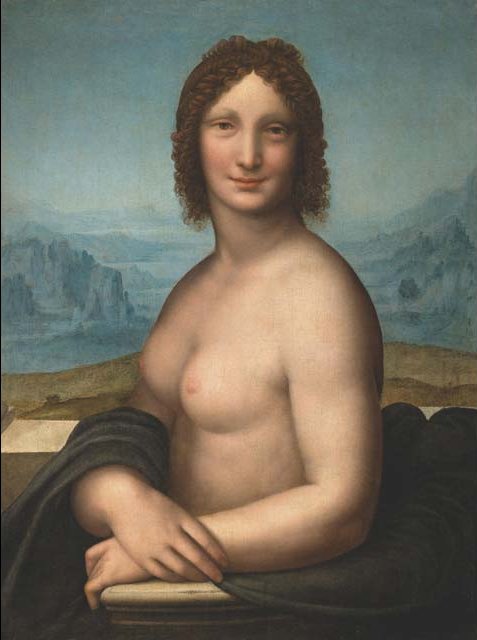|
Vertumnus And Pomona (Melzi)
''Vertumnus and Pomona'' is a painting by Francesco Melzi dated to . It depicts the Roman god of the seasons Vertumnus in the guise of an old woman attempting to woo the lady Pomona. It is in the collection of the Gemäldegalerie of the Berlin State Museums. Analysis ''Vertumnus and Pomona'' is painted in the style typical of the Leonardeschi, utilizing Leonardo da Vinci's female facial type with downcast eyes and tight smile, Leonardo's sfumato technique, and reflecting Leonardo's observation of botany.Henry, Rodman. ''GIOVANNI ANTONIO BOLTRAFFIO-A STYLISTIC STUDY OF HIS WORK'', (PhD. Dissertation, Boston University, 1959), pp. 106–108. The painting likewise draws from known Leonardo compositions from before 1513: For example, Melzi's painting had the same color scheme as Leonardo's ''Virgin and Child with Saint Anne'' at the Louvre. The tall mountains in the background, especially including the arched bridge on the left, are drawn from the background of the ''Mona Lisa.'' I ... [...More Info...] [...Related Items...] OR: [Wikipedia] [Google] [Baidu] |
Francesco Melzi
Francesco Melzi, or Francesco de Melzi (1491–1570), was an Italian painter born into a family of the Milanese nobility in Lombardy. He became a pupil of Leonardo da Vinci and remained as his closest professional assistant throughout his career. After da Vinci's death he became the literary executor of all da Vinci's papers, editing them into a manuscript on painting he published as ''Tratatto della Pittura'' reatise on Paintingor a compilation entitled the ''Codex Urbinas''. Early life and training Francesco's father, Gerolamo Melzi, was an engineer for Francesco II Sforza's military, and a captain in the militia in Milan under Louis XII. Francesco lived with his family in the Villa Melzi in Vaprio d'Adda (not to be confused with the Villa Melzi d'Eril in Bellagio, Lombardy), which today is still under the ownership of the Dukes Melzi d'Eril. Francesco grew up in the Milanese court, and was raised with proper manners and was granted a good education, which ... [...More Info...] [...Related Items...] OR: [Wikipedia] [Google] [Baidu] |
Metamorphoses
The ''Metamorphoses'' ( la, Metamorphōsēs, from grc, μεταμορφώσεις: "Transformations") is a Latin narrative poem from 8 CE by the Roman poet Ovid. It is considered his ''magnum opus''. The poem chronicles the history of the world from its creation to the deification of Julius Caesar in a mythico-historical framework comprising over 250 myths, 15 books, and 11,995 lines. Although it meets some of the criteria for an epic, the poem defies simple genre classification because of its varying themes and tones. Ovid took inspiration from the genre of metamorphosis poetry and some of the ''Metamorphoses'' derives from earlier treatment of the same myths; however, he diverged significantly from all of his models. One of the most influential works in Western culture, the ''Metamorphoses'' has inspired such authors as Dante Alighieri, Giovanni Boccaccio, Geoffrey Chaucer, and William Shakespeare. Numerous episodes from the poem have been depicted in works of sculpture, ... [...More Info...] [...Related Items...] OR: [Wikipedia] [Google] [Baidu] |
Paintings In The Gemäldegalerie, Berlin
Painting is the practice of applying paint, pigment, color or other medium to a solid surface (called the "matrix" or "support"). The medium is commonly applied to the base with a brush, but other implements, such as knives, sponges, and airbrushes, can be used. In art, the term ''painting ''describes both the act and the result of the action (the final work is called "a painting"). The support for paintings includes such surfaces as walls, paper, canvas, wood, glass, lacquer, pottery, leaf, copper and concrete, and the painting may incorporate multiple other materials, including sand, clay, paper, plaster, gold leaf, and even whole objects. Painting is an important form in the visual arts, bringing in elements such as drawing, Composition (visual arts), composition, gesture (as in gestural painting), narrative, narration (as in narrative art), and abstraction (as in abstract art). Paintings can be naturalistic and representational (as in still life and landscape art, lands ... [...More Info...] [...Related Items...] OR: [Wikipedia] [Google] [Baidu] |
Salaì
Gian Giacomo Caprotti da Oreno, better known as Salaì (1480 – January 19, 1524) was an Italian artist and pupil of Leonardo da Vinci from 1490 to 1518. Salaì entered Leonardo's household at the age of ten. He created paintings under the name of Andrea Salaì. He was described as one of Leonardo's students and lifelong companion and servant and was the model for Leonardo's '' St. John the Baptist,'' ''Bacchus and Angelo incarnato.'' Early life Salaì was born in 1480 as son of Pietro di Giovanni, a tenant of Leonardo's vineyard near the Porta Vercellina, Milan. He joined Leonardo's household at the age of ten as an assistant. Giorgio Vasari describes Salaì as "a graceful and beautiful youth with curly hair, in which Leonardo greatly delighted". Although Leonardo described him as "a liar, a thief, stubborn, and a glutton" and he stole from Leonardo on at least five occasions, he kept Salaì in his household for more than 25 years, in which Salaì trained as an artist ... [...More Info...] [...Related Items...] OR: [Wikipedia] [Google] [Baidu] |
Clos Lucé
The Château du Clos Lucé (or simply Clos Lucé), formerly called Manoir du Cloux, is a large château located in the center of Amboise, in the department of Indre-et-Loire, in the Centre-Val de Loire region of France. It is located in the natural Val de Loire (formerly called Touraine) region. Built by Hugues d'Amboise in 1471, the palace has known several famous owners such as the French king Charles VIII and Leonardo da Vinci. Clos Lucé is 500 metres from the royal Château d'Amboise, to which it is connected by an underground passageway. King Charles VIII bought the home from Etienne Le Loup in 1490 and during this time it became known as the ‘summer house’, housing French royalty. After a few decades Francis I gave it to Leonardo da Vinci when he invited him to live in France in 1516. The aging polymath lived his last years in this house, until his death on 2 May 1519. Thanks to its famous owners, this house today ranks as a ‘historical monument’ and therefore is ... [...More Info...] [...Related Items...] OR: [Wikipedia] [Google] [Baidu] |
Giampietrino
Giampietrino, probably Giovanni Pietro Rizzoli (active 1495–1549), was a north Italian painter of the Lombard school and Leonardo's circle, succinctly characterized by S. J. Freedberg as an "exploiter of Leonardo's repertory."Freedberg, 1993:383. Biography Giampietrino was a productive painter of large altarpieces, Madonnas, holy women in half figure, and mythological women. For a long time, the true identity of the artist was unknown; he was only known as a so-called "Giampietrino" whose name appeared in lists of the members of Leonardo's studio. In 1929, Wilhelm Suida suggested that he could perhaps be Giovanni Battista Belmonte, since a Madonna signed with this name and dated 1509 had been associated stylistically with Giampietrino. Since then, this assumption is considered outdated, and Giampietrino is identified predominantly with Giovanni Pietro Rizzoli, who is known through documents. Giampietrino has been regarded as a talented painter who contributed substantially ... [...More Info...] [...Related Items...] OR: [Wikipedia] [Google] [Baidu] |
Saint Petersburg
Saint Petersburg ( rus, links=no, Санкт-Петербург, a=Ru-Sankt Peterburg Leningrad Petrograd Piter.ogg, r=Sankt-Peterburg, p=ˈsankt pʲɪtʲɪrˈburk), formerly known as Petrograd (1914–1924) and later Leningrad (1924–1991), is the second-largest city in Russia. It is situated on the Neva River, at the head of the Gulf of Finland on the Baltic Sea, with a population of roughly 5.4 million residents. Saint Petersburg is the fourth-most populous city in Europe after Istanbul, Moscow and London, the most populous city on the Baltic Sea, and the world's northernmost city of more than 1 million residents. As Russia's Imperial capital, and a historically strategic port, it is governed as a federal city. The city was founded by Tsar Peter the Great on 27 May 1703 on the site of a captured Swedish fortress, and was named after apostle Saint Peter. In Russia, Saint Petersburg is historically and culturally associated with t ... [...More Info...] [...Related Items...] OR: [Wikipedia] [Google] [Baidu] |
Hermitage Museum
The State Hermitage Museum ( rus, Государственный Эрмитаж, r=Gosudarstvennyj Ermitaž, p=ɡəsʊˈdarstvʲɪn(ː)ɨj ɪrmʲɪˈtaʂ, links=no) is a museum of art and culture in Saint Petersburg, Russia. It is the list of largest art museums, largest art museum in the world by Art gallery, gallery space. It was founded in 1764 when Empress Catherine the Great acquired an impressive collection of paintings from the Berlin merchant Johann Ernst Gotzkowsky. The museum celebrates the anniversary of its founding each year on 7 December, Saint Catherine's Day. It has been open to the public since 1852. The ''Art Newspaper'' ranked the museum 6th in their list of the List of most visited art museums, most visited art museums, with 1,649,443 visitors in 2021. Its collections, of which only a small part is on permanent display, comprise over three million items (the numismatics, numismatic collection accounts for about one-third of them). The collections occupy a l ... [...More Info...] [...Related Items...] OR: [Wikipedia] [Google] [Baidu] |
Giovanni Morelli
Giovanni Morelli (25 February 1816 – 28 February 1891) was an Italian art critic and political figure. As an art historian, he developed the "Morellian" technique of scholarship, identifying the characteristic "hands" of painters through scrutiny of diagnostic minor details that revealed artists' scarcely conscious shorthand and conventions for portraying, for example, ears. He was born in Verona and died in Milan. Early life and training Morelli studied medicine in Switzerland and Germany, where he taught anatomy at the University of Munich. During this time he also studied Goethe's morphology, Lavater's physiognomy, F. Schelling's natural philosophy and befriended Bettina von Arnim. With his return to Italy he acted as a conduit for intellectual life of the North. Art historian The Morellian method The Morellian method is based on clues offered by trifling details rather than identities of composition and subject matter or other broad treatments that are more l ... [...More Info...] [...Related Items...] OR: [Wikipedia] [Google] [Baidu] |
Pierre-Jean Mariette
Pierre-Jean Mariette (7 May 1694 – 10 September 1774) was a collector of and dealer in old master prints, a renowned connoisseur, especially of prints and drawings, and a chronicler of the careers of French Italian and Flemish artists. He was born and died in Paris, and was a central figure in the artistic culture of the city for decades. Early life and training Mariette was born to a long-established and highly successful family of engravers, book publishers and printsellers in Paris. His father was Jean Mariette (1660–1742). In 1657 his father's father, Pierre Mariette (ii) (1634–1716), had bought the family business from his ailing father, Pierre Mariette (i) (1596–1657), for 30,000 livres. Family connections put him in contact as a young man with antiquarians such as the comte de Caylus, for whom Mariette would write his ''Lettre sur Leonardo da Vinci'', printed as a preface to Caylus's book on Leonardo's caricatures, 1730. In 1722 he first met the imm ... [...More Info...] [...Related Items...] OR: [Wikipedia] [Google] [Baidu] |
Frederick The Great
Frederick II (german: Friedrich II.; 24 January 171217 August 1786) was King in Prussia from 1740 until 1772, and King of Prussia from 1772 until his death in 1786. His most significant accomplishments include his military successes in the Silesian wars, his re-organisation of the Prussian Army, the First Partition of Poland, and his patronage of the arts and the Enlightenment. Frederick was the last Hohenzollern monarch titled King in Prussia, declaring himself King of Prussia after annexing Polish Prussia from the Polish–Lithuanian Commonwealth in 1772. Prussia greatly increased its territories and became a major military power in Europe under his rule. He became known as Frederick the Great (german: links=no, Friedrich der Große) and was nicknamed "Old Fritz" (german: links=no, "Der Alte Fritz"). In his youth, Frederick was more interested in music and philosophy than in the art of war, which led to clashes with his authoritarian father, Frederick William I of Prussia. ... [...More Info...] [...Related Items...] OR: [Wikipedia] [Google] [Baidu] |
Flora (Francesco Melzi)
''Flora'' (also ''La Columbina'' or ''Columbine'') is a painting by Francesco Melzi (Italian, 1491–1570), completed circa 1520. It depicts the Roman mythological figure Flora, the goddess of springtime and flowers, a popular subject among Renaissance artists. The painting was in the collection of Maria de’ Medici in 1649 and has been in the collection of Hermitage Museum since 1850. Analysis ''Flora'' was painted in the style typical of the Leonardeschi, utilizing Leonardo da Vinci's female facial type with downcast eyes, Leonardo's sfumato technique, and displaying Leonardo's penchant for careful observation of plants and hair. In the composition, Flora is seated in a grotto, surrounded by ferns and ivy. She wears the costume of an ancient Roman, with a white stola embroidered in gold and with a blue palla thrown over one shoulder. In her lap are white jasmines, and in her left hand she holds a spray of columbine that formerly gave the painting its title. The plants s ... [...More Info...] [...Related Items...] OR: [Wikipedia] [Google] [Baidu] |











